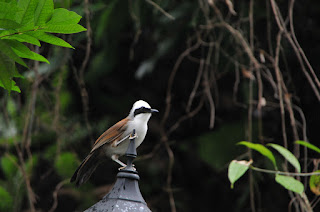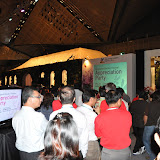We had a pleasant drive to Bt Tinggi and stayed a couple of days at Colmar Tropicale and while we did not get to see the Silver-breasted Broadbill we saw lots of birdlife at the Botanic Gardens and other parts of the Berjaya Hills development. The star bird must be the "resident" Blythe's Hawk-eagle that was sighted over the 3 days we were there.
Friends from Houston visited on their way home from their 2-week diving trip to Manado and Sorong in Indonesia, we took them to P. Ubin for a glimpse of Singapore as it was in the 1960’s. It was a nice dry day and the friendly wild boars and oriental pied hornbills were out and about to the delight of Ross & Terri.
On 7th at Telok Blangah Hill, one of the NSS third Raptor Watch sites, there was a lot of cloud cover, that reduced our sightings considerably. Even though the raptors were few there were many other birds active in the vicinity.
A friend mentioned he spotted the Spotted Wood Owl at the SBG so we met at the Jacob Ballas car park and were amazed to see this beautiful bird snoozing up in the tree.
While many different birds have been earlier recorded feeding on the fruits of the Ficus benjamina at the Bukit Timah summit our trip on 23rd was not so fruitful as only a few bulbuls were seen picking on the few remaining figs. However on the way up we sighted the Black-bearded Gliding Lizard and a female Colugo hugging a tree. Nearing the summit we heard loud bird calls and found 2 White-Bellied Sea eagles on a romantic rendezvous. Unfortunately in the heat of activity the male fell off leaving the female disappointed.
On Thursday, as we were leaving Bidadari park at 8.30am we heard a few loud bird calls, looking up we saw about 4 barbets flying onto a tree, followed by 3 larger birds that turned out to be the Oriental Pied Hornbills. With such a good view and camera ready, we took many shots. One of the Hornbills was trying to feed a female who did not show interest in the fig that was offered, while a 3rd bird was on another branch looking also not too interested in the male OPH. For a few minutes the activity on this tree increased with a White Throated Kingfisher and some Yellow-Vented Bulbuls joining the congregation. On the ground the Variable Squirrel that we had sighted earlier was busy eating. We have not seen this species in other forest areas that we have been and on checking we read this Variable Squirrel which is also known as Finlayson's squirrel could be escapees or released by pet owners.









 Successfully it landed on the mudflats to a nice meal.
Successfully it landed on the mudflats to a nice meal.  On our way back to the mainland, we were greeted by a beautiful sunset at Ubin’s jetty, a warm close to our wet afternoon walk.
On our way back to the mainland, we were greeted by a beautiful sunset at Ubin’s jetty, a warm close to our wet afternoon walk. While the heron worked hard for its meal, the bulbul and sunbird have a easier time feeding on plant seeds and nectar.
While the heron worked hard for its meal, the bulbul and sunbird have a easier time feeding on plant seeds and nectar. 
 It was also interesting to see the oriole’s skill manoeuvring the prying mantis that it had caught in order to eat it.
It was also interesting to see the oriole’s skill manoeuvring the prying mantis that it had caught in order to eat it.
























